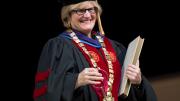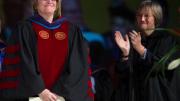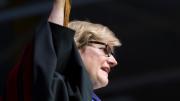Ava Clayton Spencer, who concluded 15 years of Harvard service as vice president for policy on June 30, was inaugurated as the eighth president of Bates College, in Lewiston, Maine, on Friday; the ceremony was not only resonant personally for Harvard president Drew Faust, who introduced Spencer for the installation formalities, but also underscored important themes facing many institutions of higher education today.
Spencer comes from a thoroughly academic family: her father, Samuel Reid Spencer Jr., Ph.D. ’51, was president of Mary Baldwin College from 1957 to 1968 and of Davidson College from 1968 to 1983. (At an emotional moment during her inaugural address, Clayton Spencer noted that both of her elderly parents were in attendance at the Bates ceremonies, and displayed the cap that Samuel Spencer had worn throughout his academic career.)
On Making the Academy Accessible
But Faust focused on a different element of the new Bates leader’s background, a more fundamental preparation for her new role:
Clayton Spencer was born in 1954 in North Carolina—a state in the segregated South in the year the pathbreaking Supreme Court decision, Brown v. Board of Education declared segregation unconstitutional. Clayton grew up in an environment where issues of equality and justice were the stuff of everyday lives and choices—and in an environment where education was identified as the most powerful engine for social change. As I think about all she has undertaken since those early years, I believe it has been impelled by a fierce commitment to justice and to equal opportunity that grew out of that early experience. For a time in her life, she thought to realize her purposes through the law—thus her Yale law degree and her years as an attorney and prosecutor. But ultimately Clayton found in the field of education the arena in which her belief in human possibility could find its most effective expression. From the time of the Founding Fathers, commitment to education has been seen as the fundamental vehicle of American democracy; it certainly was the taproot of the Civil Rights movement: it was not a coincidence that the landmark Brown case was about schools.
Faust might have been speaking about herself. Her essay on her own childhood, in segregated Virginia, published in Harvard Magazine in 2003 (before Faust was named Harvard's president, in 2007), probes deeply into the same social changes and stakes that Spencer lived through as a girl in North Carolina. It was unmistakable that Faust holds dear similar beliefs about access and equity.
Of her Harvard accomplishments, Faust said, Spencer “felt most passionate and most proud” about “extending opportunity to students who had abundant talent but lacked the means to afford higher education”—through both the Harvard Financial Aid Initiative launched under President Lawrence H. Summers and maintained by Faust during the financial crisis and its aftermath, and the Crimson Summer Academy, which gives low-income high-school students on-campus experiences leading to higher education. (Five academy graduates have attended Bates, Faust noted.)
Given Bates’s history (it was New England’s first coeducational institution—from its beginning, and admitted former slaves early in its history), Faust concluded, “Bates is blessed to have found its perfect president.”
The Risk of Looking "Dangerously Quaint": An Agenda for Educational Change
Spencer devoted her address, titled "Questions Worth Asking" (read the text here; see the video of Spencer delivering the address), not to celebratory pleasantries but to an analysis of the challenges facing Bates—a small, northern New England liberal-arts college; its distinctive strengths and character as it responds; and, by extension, the context in which much of private education now finds itself.
She drew on the Bates experiences of Benjamin Elijah Mays, who came to college from Ninety-Six, South Carolina, "in a county notorious for racial extremism," having cobbled together a high-school education "against all odds"—because, Spencer said, "black children in Greenwood County were allowed to attend school for only four months a year—November through February. The rest of the time they were expected to be available for farm work." In his autobiography, Mays, who went on to serve as president of Morehouse College from 1940 to 1967, wrote of his undergraduate experience and his subsequent graduate studies, “At Bates, teachers spoke to Negro students on campus and downtown, especially if the Negro student was in a professor’s class. I knew one or two professors at the University of Chicago in 1921 who never recognized a Negro student when off campus or on.” The respect accorded Mays, she said, reflected something fundamental about Bates, where "we encountered individuals in their full humanity. We took as our task educating them with intellectual rigor, ethical responsibility, and care for their fellow human beings. These qualities are in the DNA of Bates College, and they define us to this day. They also point the way forward."
Turning to today, Spencer said that information technologies are transforming higher education, making intellectual resources widely available, but posing challenges as well:
In their intellectual reach, then, Bates, and liberal arts colleges like us, have become a great deal larger. Yet enlarging the screen on which we must project our institutional identity and compete for faculty and students makes this tiny campus in Lewiston, Maine, look ever smaller. The liberal arts colleges, taken together, educate fewer than four percent of the college students in America. That fraction shrinks further against a large and growing global denominator.
Beyond sheer numbers, what Hedley Reynolds [president of Bates, 1967-1989] described as the “tough-minded tradition of the small New England college” is at risk of looking dangerously quaint in a world of rapidly growing global populations, hungry for knowledge and credentials. Furthermore, the expansion of knowledge and fields of research renders increasingly arbitrary our choices about the faculty we hire and the courses we teach.
Finally, ready access to the world’s most enticing intellectual capital at little or no cost makes the residential model of the liberal arts feel ever more expensive. With Harvard, Stanford, MIT, and other leading universities putting highly produced courses online—often in fields we don’t even teach—we can be sure that students and their parents will scrutinize intensely the value proposition of the residential liberal arts model.
To sustain a model of liberal-arts education grounded in the teaching of values, Spencer broached three areas of challenge and change facing her institution (in each instance drawing from the example of Benjamin Mays).
"Mindset": Rethinking Teaching and Learning. Spencer said, "If success for colleges and universities was defined for the past 30 years as a niche competition based on wealth and prestige, in the next decades success will go to the institutions that engage most robustly and effectively with the forces that are reshaping our world."
She outlined, broadly, changes in faculty recruitment, disciplinary organization, and teaching:
It is not enough, in the liberal arts, to circle the wagons and assume that we can keep doing what we’re doing, the way we’ve always been doing it. In a world of exploding knowledge, we need to be highly intentional about how we recruit new faculty and how we configure departments to build on our particular strengths. We need to move beyond the limits of disciplinary structures to shape intellectual capacity and curriculum in ways that respond to the evolution of fields and student curiosity, while at the same time maintaining our standards of excellence. And we need to think pragmatically about how to support faculty members who wish to adapt their pedagogy to take greater advantage of the powerful tools that are now available.
With technology turning the world into our library, we must also work with faculty and students to gain access to the range of content and modes of intellectual production that are now at our fingertips.…Given all that our students have coming at them—in the classroom, in their lives, and on their machines—they sorely need adults whom they know and respect to work with them as they learn to navigate complicated intellectual terrain.
The good class is not simply the “small” class, but rather the “engaged” class. Here, faculty, through their own passion and erudition, inspire students to take ideas seriously, and sometimes even to love them. They help students when the work gets hard—when texts resist interpretation, or require more context than an 18-year-old could possibly bring; when experiments fail in the lab; or when weeks of analysis must be scrubbed because of an error in a data set. Working closely with adults and with each other, students learn that although information may be a click away, mastery and meaning are not. Some kinds of knowledge require patience, and perseverance, and close attention.
Summarizing the challenge, she observed,
For the liberal arts college it means, among other things, recognizing that the line between theory and practice is breaking down. It means acknowledging that our students’ work with Somali children and adults in Lewiston is not only an opportunity for service, but also a venue for cultural learning at a very high level. And it means that we see the growing concern of students and parents with employment prospects not as a domain beneath our proper notice, but rather as a deep aspect of our obligation as a liberal arts college to prepare our students for a life of purposeful work. At our best, we challenge ourselves as an institution to wrestle actively and joyously with the world as we encounter it. In so doing we model this mindset for our students as they work to construct their own lives.
"Heart" and "Head." Citing Peter J. Gomes, the late Plummer professor of Christian morals and Pusey minister in the Memorial Church (a Bates alumnus in whose memory the Bates chapel was named in a ceremony on October 25), Spencer said, "[W]e put 'the making of a better person ahead of the making of a brighter person, or a better mousetrap'”—illustrating the larger point that the fundamental work of liberal arts is "the project of guiding young people through the passage from childhood to adulthood, to make them not only knowledgeable and equipped to navigate a complex world, but also motivated with empathy toward their fellow human beings." In that work, Spencer said, a college harkened back to the title of her address: helping students ask “questions worth asking,” another phrase from Gomes. Within the college community—"a powerful alchemy of the universal and the particular"—she said, students are invited to "grapple with fundamental principles even as they hone their individuality." When it works, she said, "our intimate scale creates a zone of care and concern that…produces graduates with ethical awareness and a commitment to serving purposes larger than themselves."
Community: Excellence Because of Openness. Here, Spencer turned to the problem of affordable access—“not only what community is for, but how it is constructed." In Bates's case, she said, Mays's experience of the college community was "a story of openness and inclusion, well before we had the language for such things." She continued:
The genius of American higher education is that it unites excellence and opportunity at the heart of the enterprise, allowing talented students regardless of background or means to attend our best colleges and universities, and, conversely, allowing these institutions to draw from broad pools of talent that are constantly being renewed. This is a historical accident brought to us by the G.I. Bill following World War II and codified in the Federal Higher Education Act of 1965.
Far from turning American colleges and universities into “hobo jungles,” as predicted in 1944 by University of Chicago President Robert Maynard Hutchins, the returning GIs infused our institutions with talent, energy, aspiration, and grit, producing a higher education system of unmatched vitality and intellectual power. In other words, American higher education is excellent not in spite of its openness, but because of it.
At Bates, we claim this union of excellence and opportunity as a core element of our identity, and we need to continue to build on this deep aspect of who we are. As a practical matter this means redoubling our efforts to recruit students from a wide range of backgrounds, and it means maintaining an unwavering commitment to financial aid. A residential liberal arts education is expensive for us to offer and for families to afford. Unless we are content to become a luxury good—higher education’s version of the “gated community”—we must make sure that we have the financial means to seek out and admit talented students regardless of their ability to pay.
Facing such challenges to her institution's goals, resources, and priorities, Spencer concluded with an appeal to its historic character:
[A]t Bates, we don’t have time to waste. In certain respects, we lag our peers in wealth and fame and market position. But we are not in danger of living someone else’s life. We know who we are and what we stand for, and we stand ready—together—to challenge ourselves and to engage the world.











